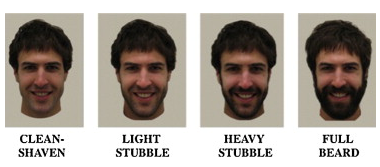Those of us interested in human evolution spend a lot of time looking into the past, so it can be easy to forget that evolution is an on-going process that continues to shape our species. One of the most often discussed forces shaping our current evolutionary trajectory is sexual selection. Simply speaking, this is the fact that certain attributes are viewed as attractive by the opposite sex – often because they indicate that the possessor would be a good mate – thus having that trait means you will be more successful at reproducing. The trait spreads throughout the population and before too long everyone has it; often to an exaggerated degree.
I find sexual selection fascinating because it means that our deeply personal opinions of what is attractive aren’t actually our own, but have been shaped by millions of years of natural selection driving us to pick the best mate. Loads of research has been published on the topic, so clearly I’m not the only one interested by the topic.
Most of this work consists of identifying a trait that a lot of people find attractive in the opposite sex, then suggesting it is sexually selected for. Some of these attractive attributes include chest and facial hair on men (perhaps because it signals the owner is mature and thus would have had time to acquire resources to invest in offspring) and a certain hip to waist ratio in women (possibly because it shows they would be good at giving birth).

Whilst having a beard was attractive, too much beard had the opposite effect. “Heavy stubble” was deemed nicer than “full beard”. Similarly, a waist to hip ratio in women that was too high or too low was deemed unattractive
The problem with this sort of research is that for evolution to occur the trait has to increase your chance of reproducing not just make people think you’re attractive. Granted being attractive probably helps, but we don’t know if the effect is significant enough to be an evolutionary driving force. Fortunately new research is being conducted to help fill in this gap in our knowledge and figure our whether what we find attractive is influencing our evolution.
An international team of researchers recorded a large group of men and asked women to rate how attractive they were. They then analysed the photographs in an effort to see what traits made a man seem attractive. The results weren’t too surprising, with things such as being tall, having a certain facial structure and so forth meaning you would be perceived as more attractive. These are the classic traits many people believe to be under the influence of sexual selection.
They then went back to these men and found out how sexually successful they were, and whether this was connected to how attractive they had been rated. The results may surprise you, because they showed that attractiveness didn’t have a strong influence on mating success. The women indicated that being a bit brawny but with a slightly feminine face and a voice that wasn’t too deep was the most attractive, but possessing those traits didn’t mean that a man would be sexually successful. The exception to this was height. Being tall was the only attractive trait that also increased the chances a man would get lucky.
So what about men made them likely to be successful with the ladies? The researchers got a group of men to also look at these individuals and rate them in terms of how dominant they looked. Interestingly, they found that being perceived as more dominant was much better at predicting whether or not the man would be sexually successful. Dominant traits included a very deep voice, overly masculine face and other traits which were the exact opposite of what women found most attractive.

Whilst being dominant may help with the ladies, I don’t think this will
Evolutionary speaking, this would mean it was competition between men rather than appealing to women which was the primary driving force behind the development of many masculine traits, such as a deep voice. Further, this continues to be a powerful force in the present day, with more dominant men getting more ladies than even the most attractive guy; as counter-intuitive as this may seem.
However, this study is far from perfect. For example, they don’t bother looking at personality. It may be that the most attractive people are as fun to be around as a donkey’s anus, hence why they don’t have as much success as one might think. Further, this was a fairly limited study, only examining 63 men or so from one part of the world (and asking a mere 72 women what they found attractive). It may be that this handful of women had an unusual taste.
So, whilst more research is needed these results clearly have fascinating implications. They suggest that the development of “manly” traits was actually the result of men trying to out-compete other men and ultimately being good as such competition is what will get a guy the ladies. Conversely, being an attractive man doesn’t translate to mating success, suggesting sexual selection may not be as an important force in our evolution as once thought.
References
Dixson AF, Halliwell G, East R, Wignarajah P, & Anderson MJ (2003). Masculine somatotype and hirsuteness as determinants of sexual attractiveness to women. Archives of sexual behavior, 32 (1), 29-39
Dixson, B. J., & Brooks, R. C. (2013). The role of facial hair in women’s perceptions of men’s attractiveness, health, masculinity and parenting abilities.Evolution and Human Behavior.
Sybil A Streeter, Donald H McBurney (2002). Waist–hip ratio and attractiveness: New evidence and a critique of “a critical test” Evolution and Human Behavior, 24 (2), 88-98
Wheatley, J. R., Dawood, K., Shriver, M. D., & Puts, D. A. (2013). Quantifying the strength and form of sexual selection on men’s traits.
Apologies for any adds you see in the article, I have no control over them. In fact, I can’t even seem to figure out what spawns them, different phrases light up as adverts each time I load the page

